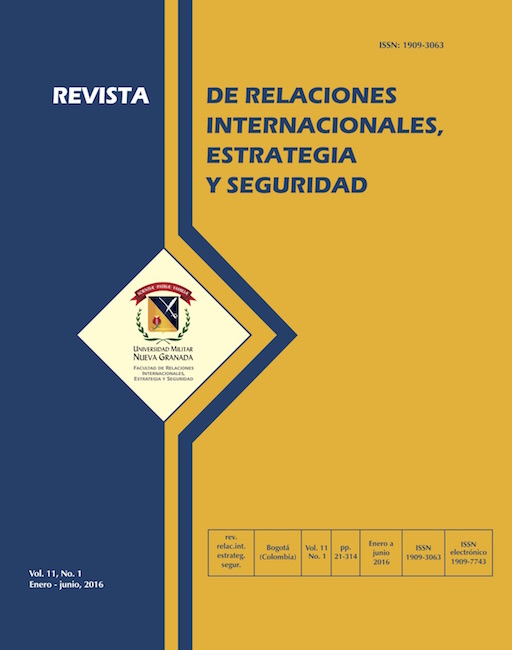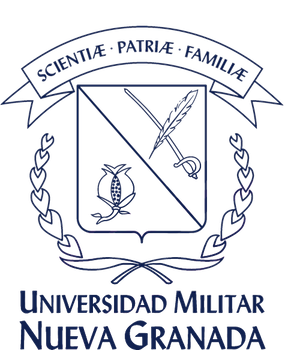¿Cuándo las redes transgubernamentales son la mejor opción para tratar amenazas en Bioseguridad? una revisión del estado de la cuestión
Resumen
Parto del supuesto de que los Estados eligen conscientemente entre diferentes arreglos institucionales porque consideran que unos son más convenientes que otros para enfrentar nuevos problemas o condiciones. En el campo de la bioseguridad arguyo que la elección está confinada a dos tipos de organizaciones: redes transgubernamentales (RTG) y organizaciones intergubernamentales. Asimismo, sostengo que bajo determinadas condiciones los actores deliberadamente optan por las RTG debido a que las califican como arreglos institucionales superiores. A pesar de que los Estados continúan dependiendo de los tratados formales para dirigir la cooperación en seguridad, muchos de éstos han sido complementados por una variedad de RTG. Debido a su flexibilidad, rapidez y bajos costos en materia de soberanía, muchos anticipan que las RTG serán el vehículo preferido para llevar a cabo la cooperación internacional al desempeñar muchas funciones de gobernanza global pero sin tener la forma de las organizaciones más estructuradas. De ahí, que el objetivo de este ensayo sea evaluar la literatura enfocada en las redes transgubernamentales, legalización y diseño institucional racional, así como conjugar y aplicar algunas de sus teorías al área de la bioseguridad. Por último, discuto dos posibles explicaciones rivales al enfoque racionalista.Descargas
Lenguajes:
enReferencias bibliográficas
Abbott, K. & Duncan, S. (2000). Hard and Soft Law in International Governance. International Organization. 54(3). 421-456. http://dx.doi.org/10.1162/002081800551280
Abbott, W.; Keohane, R.; Moravcsik, A.; Slaughter, A. & Duncan, S. (2000). The Concept of Legalization. International Organization. 54(3). 401-419. http://dx.doi.org/10.1162/002081800551271
Aginam, O. (2007). Diplomatic rhetoric or rhetorical diplomacy: the G8 and global health governance. In. Cooper, A.; Kirton, J. & Schrecker, T. (Ed.). Governing global health: challenge, response and innovation. (pp. 147 - 55). Burlington: Ashgate Publishing.
Avery, D. (2010). The North American Plan for Avian and Pandemic Influenza: A case study of regional health security in the 21st century. Global Health Governance. 3(2). 1-26. http://www.ghgj.org/Avery_the%20North%20America%20plan%20for%20influenza.pdf
Bayne, N. (2000). Hanging in there : the G7 and G8 summit in maturity and renewal. Brookfield: Ashgate.
Bermann, G. (2000). Transatlantic regulatory cooperation: legal problems and political prospects. New York: Oxford University Press.
Chand, S.; Morrison, S.; Piot, P. & Heymann. D. (2010, june 23). From G8 to G20, is health next in line? The Lancet. http://c657621.r21.cf2.rackcdn.com/commissioners/lancetg8g20.
Cooper, A.; Kirton, J. & Schrecker, T. (Eds.) (2007). Governing global health: challenge, response, innovation. Burlington: Ashgate.
Eilstrup-Sangiovanni, M. (Forthcoming). Transgovernmental Networks and Institutional Design: Insights from the evolving Transgovernmental Non-proliferation Regime
Eilstrup-Sangiovanni, M (2009). Varieties of cooperation. Government networks in international security. In. Kahler, M. (Ed.). Networked politics: agency, power, and governance. (pp. 194 -227). Ithaca: Cornell University Press.
Enserink, M. & Cohen, J. (2009). Virus of the year. The novel H1N1 influenza. Science (New York). 326. 1607. doi: 10.1126/science.326.5960.1607. http://dx.doi.org/10.1126/science.326.5960.1607
Fidler, D. (2005). From International Sanitary Conventions to Global Health Security: The New International Health Regulations. Chinese Journal of International Law. 4(2). 325-392. http://dx.doi.org/10.1093/chinesejil/jmi029
Fidler, D. & Ogalthorpe, L. (2008). Biosecurity in the global age: biological weapons, public health, and the rule of law. Stanford: Stanford University Press.
Fratianni, M. (2007). Sustaining Global Growth and Development : G7 and IMF Governance. Farnham: Ashgate Publishing.
Garret, L. & Alavian, E. (2010). Global Health Governance in a G-20 World. Global Health Governance. 4(1). 1 - 14.
George, A. & Bennett, A. (2005). Case studies and theory development in the social sciences. Cambridge: MIT Press.
Hajnal, P. (2002). Civil society in the information age. Hampshire: Ashgate.
Hillmer, N. (2002). Canada among nations. Ontario: Oxford University Press.
Hodges, M. (1999). The G8's role in the new millennium. Brookfield: Ashgate.
Hoffman, S. (2010). The evolution, etiology and eventualities of the global health security regime. Health Policy and Planning. 25(6). 510-522. http://dx.doi.org/10.1093/heapol/czq037
Kahler, M. (2009a). Networked Politics. Agency, power, and governance. In. Kahler, M. (Ed.) Networked politics: agency, power, and governance. (pp. 1 - 20). Ithaca: Cornell University Press.
Kahler, M. (Ed.). (2009b). Networked politics: agency, power, and governance. Ithaca: Cornell University Press.
Keohane, R. (1984). After Hegemony: Cooperation and Discord in the World Political Economy. Princeton: Princeton University Press.
Keohane, R. & Nye, J. (1974). Transgovernmental Relations and International Organizations. World Politics: A Quarterly Journal of International Relations. 27(1). 39. http://dx.doi.org/10.2307/2009925
Kickbusch, I.; Hein, W. & Silberschmidt, G. (2010). Addressing Global Health Governance Challenges through a New Mechanism: The Proposal for a Committee C of the World Health Assembly. Journal of Law, Medicine and Ethics. 38(3). 550-563. http://dx.doi.org/10.1111/j.1748-720X.2010.00511.x
King, G.; Keohane, R. & Verba, V. (1994). Designing social inquiry: scientific inference in qualitative research. Princeton: Princeton University Press.
Kirton, J. (2001). New directions in global economic governance: managing globalisation in the twenty-first century. Burlington: Ashgate.
Kirton, J. & Mannell, J. (2005). The G8 and Global Health Governance. In. G7/G8 Information Centre. https://tspace.library.utoronto.ca/bitstream/1807/4898/1/kirton_waterloo2005.pdf.
Kirton, J. & Mannell, J. (2007). The G8 and Global Health Governance. In Cooper, A.; Kirton, J. & Schrecker, T. (Ed.). Governing global health: challenge, response and innovation. (pp. 115 -146). Burlington: Ashgate Publishing Ltd.
Kirton, J. & Kokotsis, E. (2005). Freedom, prosperity, and security G8 partnership with Africa: Sea Island 2004 and beyond. New York: Council on Foreign Relations.
Koremenos, B.; Lipson, C. & Snidal, D. (2001). The Rational Design of International Institutions. International Organization. 55(04). 761-799. doi: 10.1162/002081801317193592. http://dx.doi.org/10.1162/002081801317193592
Krahmann, E. (2005). Security Governance and Networks: New Theoretical Perspectives in Transatlantic Security. Cambridge Review of International Affairs. 18(1). 15-30. http://dx.doi.org/10.1080/09557570500059514
Labonte, R. (2007). Foreign policy matters: a normative view of the G8 and population health. Bulletin World Health Organization. 85(3). 185-191. http://dx.doi.org/10.2471/BLT.06.037242
Lipson, C. (1991). Why are Some International Agreements Informal? International Organization. 45(4). 495-538. http://dx.doi.org/10.1017/S0020818300033191
Lipson, M. (2006). Transgovernmental Networks and Nonproliferation: International Security and the Future of Global Governance. International Journal. 61(1) 179-198. doi: 10.2307/40204137. http://dx.doi.org/10.2307/40204137
Nuzzo, J. & Gronvall, G. (2011). Global Health Security: Closing the gaps in responding to infectious disease emergencies. Global Health Governance. 4(2). 1-15.
Ollila, E. (2005). Global health priorities - priorities of the wealthy? Globalization and health. 1(6). www.globalizationandhealth.com/content/1/1/6.
Podolny, J. (1998). Network Forms of Organization. Annual Review of Sociology. 24. 57. http://dx.doi.org/10.1146/annurev.soc.24.1.57
Pollack, M. (2005). The New Transatlantic Agenda at Ten: Reflections on an Experiment in International Governance. Journal of Common Market Studies. 43(5). 899-919. http://dx.doi.org/10.1111/j.1468-5965.2005.00601.x
Pollack, M. & Shaffer, G. (2001). Transatlantic governance in the global economy. Lanham: Rowman & Littlefield.
Price-Smith, A. (2001). Plagues and politics: infectious disease and international policy. Hampshire; New York: Palgrave. http://dx.doi.org/10.1057/9780230524248
Price-Smith, A. (2002). The health of nations infectious disease, environmental change, and their effects on national security and development. Cambridge: MIT Press.
Puetter, U. (2006). The Eurogroup. Manchester: Manchester University Press. http://dx.doi.org/10.7228/manchester/9780719074035.001.0001
Rathbun, B. (2011). Before Hegemony: Generalized Trust and the Creation and Design of International Security Organizations. International Organization. 65(2). 243-273. http://dx.doi.org/10.1017/S0020818311000014
Raustiala, K. (2002). The Architecture of International Cooperation: Transgovernmental Networks and the Future of International Law. Virginia journal of international law. 43(1). 1. http://dx.doi.org/10.2139/ssrn.333381
Review Committee on the Functioning of the IHR (2005, 2011). Implementation of the International Health Regulations (2005). Report of the Review Committee on the Functioning of the International Health Regulations (2005) in relation to Pandemic (H1N1) 2009. http://apps.who.int/gb/ebwha/pdf_files/WHA64/A64_10-en.pdf.
Scharpf, F. (1997). Games real actors play: actor-centered institutionalism in policy research. Boulder: Westview Press.
Scherrer, A. (2009). G8 against transnational organized crime. Burlington: Ashgate Publishing.
Schrecker, T.; Labonte, R. & Sanders, D. (2007). Breaking faith with Africa: the G8 and population health after Gleneagles. In. Cooper, A.; Kirton, J. & Schrecker, T. (Ed.). Governing global health: challenge, response and innovation. (pp. 181 - 205). Burlington: Ashgate Publishing.
Slaughter, A. (1997). The Real New World Order. Foreign affairs. 76(5). 183. http://dx.doi.org/10.2307/20048208
Slaughter, A. (2003). Global government networks, global information agencies and disaggregated democracy. Michigan journal of international law. 24(4). 1041.
Slaughter, A. (2004a). A new world order. Princeton: Princeton University Press.
Slaughter, A. (2004b). Disaggregated Sovereignty: Towards the Public Accountability of Global Government Networks. Government and Opposition. 39(2). 159-190. http://dx.doi.org/10.1111/j.1477-7053.2004.00119.x
Wendt, A. (2001). Driving with the Rearview Mirror: On the Rational Science of Institutional Design. International Organization. 55(4). 1019-1049. http://dx.doi.org/10.1162/002081801317193682
World Health Organization, WHA. (2005). International Health Regulations. http://apps.who.int/iris/bitstream/10665/43983/1/9789243580418_spa.pdf
Zaring, D. (1998). International Law by Other Means: The Twilight Existence of International Financial Regulatory Organizations. Texas International Law Journal. 33(2). 281 - 330.












